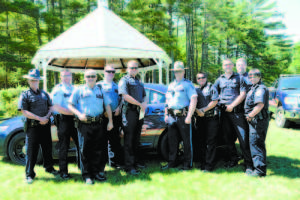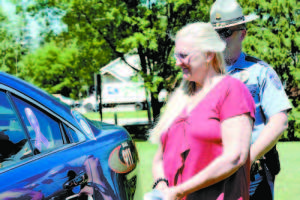Domestic abuse comes in many forms

TAKING A STAND ON DOMESTIC ABUSE — Fryeburg Police Officers left to right: David Arsenault, Andrew Jarman, Timothy Libby, Cody Belyea, Chief Joshua Potvin, Lt. Michael McAllister, Michelle Legare, Brandon Weckbacher, Harry Sims and Heidi Johnston.
Fryeburg Police Domestic Violence Awareness Ribbons
Fryeburg Selectmen voted unanimously in late May to allow the placement of purple domestic violence awareness ribbons on the Police Department’s cruisers and make them part of the permanent scheme.
The ribbons were requested by Chief Joshua Potvin to help officers spread domestic violence awareness while on patrol.
Fryeburg Police joined domestic violence advocates and supporters at Bradley Park on Main Street in Fryeburg last week for the unveiling of the ribbons. Lifelong resident and domestic violence survivor Donna Woodward placed the final ribbon on the cruiser at the ceremony.
“The ribbons will be a great additional to our cruisers and I am pleased to have the selectmen’s support in helping spread domestic violence awareness. The ribbons display our ‘no excuse’ approach to these types of crimes. It is our policy to ensure those affected by domestic violence receive the proper support they need and to hold their offenders accountable,†Chief Joshua Potvin said.
The chief added, “Over half of the homicides in Maine were domestic violence related in 2014. Unfortunately, Fryeburg was not exempt from the chilling domestic violence homicide statistics and had the first domestic violence homicide for Maine in 2015.â€
The chief said domestic violence cases drain the department’s resources and create a substantial safety risk to local officers.
“These are crimes that not only affect those involved, but the community as a whole,†Chief Potvin said. “We have reconstructed our response to domestic violence calls and have a mandatory arrest policy in place. With help from our partners at Family Crisis, Starting Point and Safe Voices, we conduct follow-up interviews with the victims within 48 hours of the incident to ensure he/she is receiving the help they need. Our officers are all trained in risk assessment to predict the likelihood of suspects re-offending.â€
The main purpose of displaying the domestic violence ribbons on FPD cruisers is to let the community know local police will support victims.
“We equally wanted to send the message to offenders that there is no excuse and we will hold them accountable,†Chief Joshua Potvin said.
By Emily Butterfield
Contributing Writer
FRYEBURG — On a bright and sunny Wednesday afternoon, Fryeburg Police Chief Joshua Potvin hoped to keep a bright light on a disturbing problem — domestic violence — through the use of a simple decal.
Chief Potvin stood in front of his fellow policemen and domestic violence advocacy groups in Bradley Park to unveil the new purple ribbon decals that will be on all the police cruisers.
Spurred not only by the revamped policy involving all domestic abuse (mandatory arrests and 48 hour follow ups with victims), but the homicide of Jody Buzzell, who was murdered by her husband Mark in January before turning the gun on himself, Chief Potvin asked Fryeburg selectmen to approve the decals at the May 28 meeting to send a message to the community that there is, “No excuse†for domestic abuse and violence in Fryeburg.
“We want to let the community know that we support them and let offenders know they’re accountable for their actions,†he said on Wednesday, June 24.
Donna Woodward also attended and spoke out against domestic abuse.
“It used to be seen as a husband and wife issue,†she said, relaying her own experience. “Abuse comes in many forms, and people should be aware of the signs.â€
The signs of domestic abuse can be difficult to determine at first, but for men and women who have experienced an abusive relationship, it can become crystal clear very quickly. One woman, Jen (not her real name), tells of her experience in an abusive and violent relationship when she was just 16 years old.
Jen met Adam not long before he was incarcerated for four years in prison.
“I wrote to him when he was in jail,†she said.
The first stage in an abusive relationship is to charm the victim and lure them into a false sense of safety, which is exactly what Adam did.
“He would write the sweetest letters and had such a way with words,†she says of the beginning of their relationship. “When he got out he was so kind, but it didn’t last long.â€
The next phase in the abusive relationship is to isolate the victim: to keep them from having contact with their friends, family or anyone who could potentially help them get out of the relationship.
Jen says that one of the factors that contributed to her being so cut off from everyone was when her mother tried to break up one of their fights. When Adam left in a fit of rage, he told Jen not to return home anymore, and to come stay with him instead, which she obliged, unbeknownst to what would happen next.
“He literally would not let me come home,†Jen said.
She said she wasn’t allowed to hang out with her friends anymore, she had to make sure when she went out with him she didn’t look at other men, and she had to dress a certain way.

ADVOCATE Donna Woodward placed a domestic violence awareness "No Excuse" ribbon on a Fryeburg Police Department cruiser.
It was so controlling that Adam would call her on the phone asking what she was wearing and would then drive nearly two hours away to her dorm room in college make sure she was telling the truth.
“I couldn’t even go in the store if there were guys in there. He would make it seem like I was going in there to show off,†she said. “They make it seem like it’s your fault.â€
The next stage is violence. Jen remembers Adam choking her so hard that she thought she was going to die.
“When you have no control over someone choking you, you just let go. Like, ‘alright, I’m going to die,’†she says, her voice cracking and tears forming in her eyes.
Many people wonder why after the first instance of abuse, a victim would stay with the perpetrator, but as Jen explains, it’s often not that easy to just leave.
“He would cry and would feel bad and say it would never happen again, and I believed it every time,†Jen said.
Often the victim is so broken emotionally and isolated from anyone who could potentially help them that the fear of what may happen if they leave is too great. Other times, they are physically unable to leave.
“He wouldn’t even let me leave. We would fight and I would try to leave and he wouldn’t let me go,†she said.
Jen rationalized the abuse by saying to herself, “he loved me so much, that’s why he’s so crazy about me … it’s just normal to you when you’re living it.â€
This is very typical behavior. It takes an average of seven times before an abused victim will finally leave.
Jen was finally able to leave after Adam admitted to cheating on her. When she learned of the affair, she called him on the phone at work. She told him, “Thank you, thank you for finally letting me go.â€
For years afterward, Jen was terrified of Adam even after the abuse ended. For years, she was plagued by nightmares of him chasing her down and killing her.
Jen’s case is a very typical case of abuse. According to the April 2014 report by the U.S. Department of Justice, women aged 18 to 24 are the most likely to find themselves in an abusive relationship.
A disturbing fact is that from 2003 to 2012, domestic abuse made up 21% of all violent crimes reported. It’s estimated, however, that only half of domestic disturbances are reported to the police, something Jen knows all to well.
In one particular instance, Jen and Adam were arguing outside, when suddenly Adam lunged at her and bit her neck so hard that she screamed. When the police were called, she immediately made up a story about what happened.
“I told them it had nothing to do with him. What was I going to do, tell them it was him and get beat up later on?†she said.
Abuse is often masked by not only by the abuser, but the victim as well. It can be difficult for others to see anything is wrong when the couple can sometimes appear so happy.
“People loved him. They loved us as a couple; we were a cute couple, but people didn’t know he was evil,†she said.
This is not unusual for victims of domestic abuse — around 77% of all domestic violence incidences happen near or at the victim’s home.
Jen is one of thousands of victims of domestic assault. In 2013 alone, there were 5,487 domestic assaults in Maine; in 1999 there were 3,986.
Oxford County saw an increase in domestic violence incidences from 223 in 2012 to 246 in 2013. Cumberland County, however, saw a decrease of 1,039 domestic violence reports in 2012 to 935 in 2013. More harrowing is that half of all homicides in Maine are related to domestic violence. According to the Maine Domestic Abuse Homicide Review Panel, from 2012-2013, there were 23 domestic homicides, accounting for 46% of all Maine homicides.
No town is exempt from the growing trend of domestic abuse and violence. In 2012, Fryeburg had 18 domestic violence incidences, 14 in 2014, and so far in 2015 there have been 14.
So what is leading to the rise in cases being reported? It has to do with victims seeking more help, says Jane Morrison of the advocacy group Safe Voices.
Safe Voices, based in Oxford, Franklin and Androscoggin county, aims to help victims of domestic abuse with the resources that they need. They provide emergency support to victims and changing legislation to help better protect victims.
They also provide shelters for victims, advocates who will attend court hearings to support women and men of domestic abuse and educating children in schools about better ways of solving problems without resorting to violence.
“Domestic violence is an inherited ill. It’s passed down generation to generation to generation,†Morrison said. “The only way to stop it is with the younger generation.â€
She also says that they provide a program for convicted offenders called Alternatives to Abuse, which aims to help them change their behavior and not repeat the cycle.
Safe Voices’ main goal is to support and empower victims. Morrison says that if anyone suspects that someone they love is a victim of domestic abuse they should ask if they’re okay.
“People are afraid to get involved, but it can provide an outlet for the victim to talk about what’s going on,†she said.
For those seeking help, there is a 24-hour help line manned by volunteer staff that can refer victims to the appropriate outreach program in their area: 1-800-559-2927.

